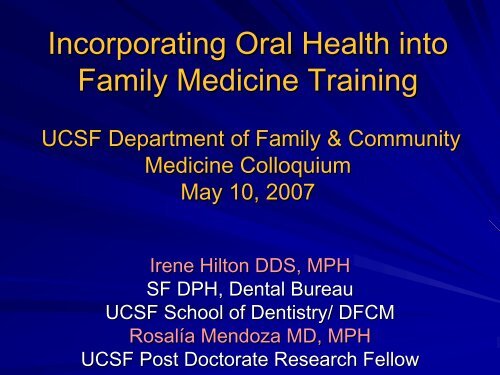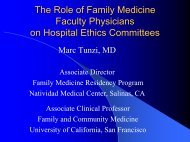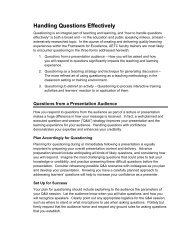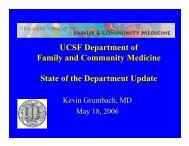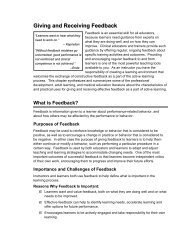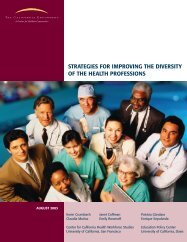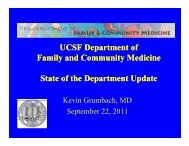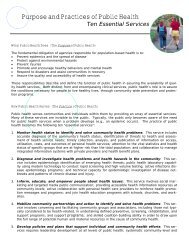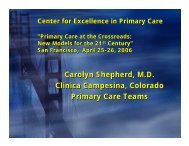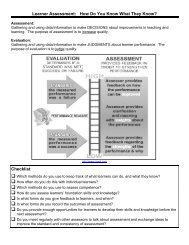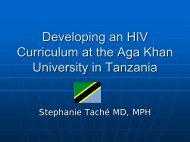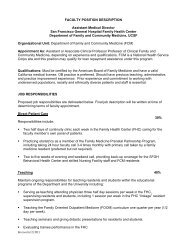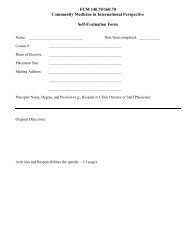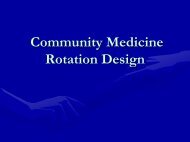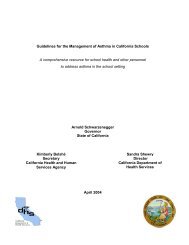Incorporating Oral Health into Family Medicine Training - Family and ...
Incorporating Oral Health into Family Medicine Training - Family and ...
Incorporating Oral Health into Family Medicine Training - Family and ...
Create successful ePaper yourself
Turn your PDF publications into a flip-book with our unique Google optimized e-Paper software.
<strong>Incorporating</strong> <strong>Oral</strong> <strong>Health</strong> <strong>into</strong><br />
<strong>Family</strong> <strong>Medicine</strong> <strong>Training</strong><br />
UCSF Department of <strong>Family</strong> & Community<br />
<strong>Medicine</strong> Colloquium<br />
May 10, 2007<br />
Irene Hilton DDS, MPH<br />
SF DPH, Dental Bureau<br />
UCSF School of Dentistry/ DFCM<br />
Rosalía a Mendoza MD, MPH<br />
UCSF Post Doctorate Research Fellow
Session Objectives<br />
Underst<strong>and</strong> the rationale for incorporating oral<br />
health (OH) <strong>into</strong> <strong>Family</strong> <strong>Medicine</strong> Education<br />
Describe the various educational components of the<br />
UCSF <strong>Family</strong> <strong>Medicine</strong> (FM) OH program<br />
Underst<strong>and</strong> the educational role of the Childhood<br />
OH Clinic<br />
Describe Clinical Results<br />
Review Impact Evaluation
Rational for Medical <strong>Training</strong> in<br />
<strong>Oral</strong> <strong>Health</strong><br />
Surgeon General Report 2000<br />
Disparities exist in OH status that can be<br />
reduced through early identification <strong>and</strong> mgt in<br />
medical setting<br />
Emerging research continues to explore the<br />
associations between OH conditions <strong>and</strong><br />
systemic health, while defining biological<br />
mechanisms<br />
Collaboration between dental <strong>and</strong> medical fields<br />
continues to exp<strong>and</strong>
The Caries Etiology Triad<br />
<strong>Oral</strong> bacteria (Strep mutans) break down<br />
dietary sugars <strong>into</strong> acids which eat away<br />
the tooth<br />
Bacteria<br />
Teeth<br />
Caries<br />
Sugars
Early Childhood Caries Disparities<br />
% 2-4 y/o Untreated Decay<br />
Percent<br />
35<br />
30<br />
25<br />
20<br />
15<br />
10<br />
19.3<br />
24.6<br />
31.5<br />
5<br />
0<br />
2-4 Years<br />
NHANES 1999-2000<br />
Non-Hispanic White Non-Hispanic Black Mexican American<br />
Data Source: NHANES IV, 1999-2000, NCHS/CDC.
UCSF <strong>Oral</strong> <strong>Health</strong> Program<br />
Goals<br />
Increase OH awareness for medical<br />
students <strong>and</strong> FM residents<br />
Provide a practical, h<strong>and</strong>s-on clinical<br />
educational experience<br />
Screen children ages 0-50<br />
5 for early<br />
childhood caries (ECC)<br />
Improve pediatric dental access<br />
Evaluate pilot program
The OH Curriculum Components<br />
Didactic Lectures<br />
Preview CD for Learners<br />
OH Screening Clinic Rotation<br />
Evaluation
<strong>Family</strong> <strong>Health</strong> Center<br />
Screening Clinic Logistics<br />
Screening:<br />
– Referral only<br />
– All children 0-50<br />
5 referred by PCPs (MD, NP)<br />
– Regardless of established dental home<br />
Two ½ day clinics/ month, 30 minute visits<br />
Families seen by OH teamlet
<strong>Oral</strong> <strong>Health</strong> Learners<br />
2 nd year UCSF <strong>Family</strong><br />
<strong>Medicine</strong> Residents<br />
3 rd year UCSF<br />
FCM 110 Medical<br />
Students (in San<br />
Francisco)<br />
OH Teamlet<br />
Teachers<br />
FCM Clinical<br />
Instructor<br />
DPH Dentist<br />
(Trainer to Trainer<br />
Model)
Conduct Early Childhood Caries Risk Screening<br />
Supervising Attending: _____________________________CHN # ____________ Date of Service: __________<br />
COMMUNITY HEALTH NETWORK<br />
SAN FRANCISCO GENERAL<br />
HOSPITAL MEDICAL CENTER<br />
FAMILY HEALTH CENTER<br />
PEDIATRIC ORAL HEALTH SCREENING<br />
PROGRESS NOTE<br />
NAME<br />
DOB<br />
MRN<br />
PCP<br />
Patient ID / Addressograph<br />
Chief complaint or reason for referral-<br />
Caries risk indicators Š based on parent interview Y N Notes<br />
(a) Mother/ primary caregiver has had active dental decay in past<br />
12 months<br />
(b) Older siblings with history of dental decay<br />
(c) Continual use of bottle containing beverages other than<br />
water/milk. Bottle use > 24months old.<br />
(d) Child sleeps with a bottle or nurses on dem<strong>and</strong><br />
(e) Frequent (greater 3x/day total) c<strong>and</strong>y, carbohydrate snacks<br />
(junk food), soda, sugared beverages (including processed juice)<br />
(f) Medical Issues:<br />
1. Saliva-reducing meds (asthma, seizure, hyperactivity etc.)<br />
2. Developmental problems etc.<br />
3. H/O anemia or Fe+ Rx<br />
Protective factors Š based on parent interview Y N Notes<br />
(a) Child lives in fluoridated community AND drinks tap water daily<br />
(b) Teeth cleaned with fluoridated toothpaste (pea size) daily<br />
(c) Child has a dental home <strong>and</strong> regular dental care<br />
<strong>Oral</strong> examination Y N<br />
a) Obvious white spots (decalcifications), or obvious decay<br />
present on the childÕs teeth: NOTE ON DIAGRAM →<br />
(b) Plaque is obvious on the teeth <strong>and</strong>/or gums bleed easily<br />
ECC (Early Childhood Caries) Diagnosis:<br />
No visible ECC<br />
Non-cavitated ECC<br />
Cavitated ECC<br />
Initial<br />
Follow-up<br />
R<br />
Assessment: ChildÕs caries risk status (any checked item in shaded areas confers high risk):<br />
L<br />
LOW HIGH<br />
Plan: <strong>Health</strong> education h<strong>and</strong>outs<br />
Self Management Goals 1._______________________________________________________<br />
2._______________________________________________________<br />
Dispense toothpaste <strong>and</strong> toothbrush<br />
Prophy/ fluoride varnish<br />
FHC <strong>Oral</strong> <strong>Health</strong> Clinic follow-up appointment (high risk) _______ months<br />
Urgent outside dental referral (high risk, needs tracking)<br />
Routine dental referral for dental home (all others)<br />
Signature of Rendering Provider: ________________<br />
_____ Name: __________________CHN # ___________
Knee-to<br />
to-Knee Exam<br />
• Conduct oral exam<br />
• Demonstrate tooth brushing<br />
• Fluoride Varnish application<br />
1. Child is facing caregiver in a straddle position<br />
2. Child leans back onto examiner while caregiver<br />
holds child’s h<strong>and</strong>s.<br />
3. Provider performs exam while caregiver holds<br />
child’s h<strong>and</strong>s & arms.
<strong>Oral</strong> <strong>Health</strong> Screening Clinic Visit<br />
Anticipatory Guidance<br />
– Educational h<strong>and</strong>outs<br />
– Language appropriate, individually<br />
tailored action plan by individual risk<br />
assessment<br />
Disposition (3 options)<br />
– Routine outside referral<br />
– In-house F/U<br />
– Urgent referral
First 11 months<br />
Children Seen<br />
117 patients<br />
Payer Source<br />
Average 5 visits/ clinic<br />
Goal: 6 visits clinic<br />
MCAL<br />
HK<br />
HF<br />
Gateway
Ethnicity of Children Screened<br />
8%<br />
13%<br />
2% Latino<br />
Asian Other (Chinese,<br />
VN)<br />
Filipino<br />
5%<br />
5%<br />
67%<br />
Middle Eastern<br />
African American<br />
Caucasian
Most Children Lacked a Dental<br />
Home<br />
# Seen<br />
90<br />
80<br />
70<br />
60<br />
50<br />
40<br />
30<br />
20<br />
10<br />
0<br />
89<br />
28<br />
18<br />
No Yes Return Visit<br />
Dental Home
Categories of Tooth Decay<br />
No ECC<br />
Non-Cavitated ECC<br />
Cavitated ECC
Caries Severity Distributed by Age<br />
4+<br />
Age<br />
3<br />
2<br />
1<br />
Cavitated ECC<br />
Non-Cavitated ECC<br />
No ECC<br />
< 1<br />
0 5 10 15 20<br />
# Seen
Bottled Water Usage at <strong>Family</strong><br />
<strong>Health</strong> Center<br />
13<br />
Bottled Water<br />
43<br />
61<br />
SF Tap Water (Filtered<br />
15)<br />
Mixed (Filtered 1)
Clinical Summary Points<br />
Majority of screened children are at high risk to<br />
develop caries<br />
More than half already have evidence dental<br />
decay on initial screening<br />
Most children do not have a dental home &<br />
receive delayed care<br />
Many children had been lost to dental F/U<br />
Most families not drinking SF fluoridated tap<br />
water
Resident Evaluation<br />
Prior to training:<br />
– Most knew of OH skills from Peds rotation<br />
– Reported low “level of comfort” performing OH<br />
screening <strong>and</strong> exam skills<br />
– Reported conducting OH skills infrequently<br />
– Inappropriately delaying referrals<br />
– Unaware of the dental referral system
After training:<br />
Resident Learners<br />
– Reported increased frequency of screening,<br />
conducting exams, appropriate dental<br />
referrals<br />
– Reported increased “level of comfort” while<br />
performing OH skills<br />
– Many reported “very likely” to perform OH<br />
techniques after residency<br />
– Fewer reported “likely” to perform fluoride<br />
varnish applications after residency
Medical Student Learners<br />
Lack knowledge of age appropriate<br />
referral<br />
Reported seeing fewer children at baseline<br />
Reported similar “comfort level” as<br />
residents after training<br />
Reported lower “comfort level” to perform<br />
OH skills in “didactic only” group vs.<br />
“lecture plus clinic experience” group
Qualitative Comments<br />
Excellent h<strong>and</strong>s-on repetition of skills<br />
No exposure in prior training – much<br />
needed exposure<br />
Great supplementary material<br />
I enjoyed the people who educated me<br />
<strong>and</strong> interacting with patients<br />
Will refer patients more<br />
All said they would recommend this<br />
training to other MS <strong>and</strong> residents
Educational Summary Points<br />
Medical students <strong>and</strong> FM residents are<br />
interested in acquiring basic clinical skills<br />
in oral health.<br />
The clinical experience component is<br />
critical to gaining competency <strong>and</strong> learner<br />
satisfaction.<br />
Medical-Dental Collaboration works!
UCSF <strong>Oral</strong> <strong>Health</strong> Pilot Program<br />
Collaborators<br />
Dr. Francisco Ramos-Gomez, UCSF School of<br />
Dentistry<br />
Dr. Irene Hilton, SF DPH, Dental Bureau<br />
First Five California/ Molina <strong>Health</strong>care, Inc.<br />
UCSF Center to Address Disparities in<br />
Children’s <strong>Oral</strong> <strong>Health</strong> (CANDO)
Funders


